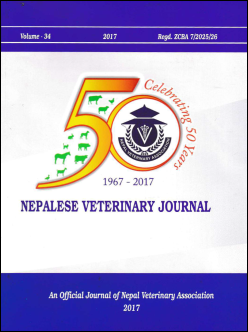Impact of Climatic Variability on Sheep Husbandry Practices at Lamjung District
DOI:
https://doi.org/10.3126/nvj.v34i0.22916Keywords:
Adaptation, climate change, Lamjung, sheep, surveyAbstract
This study was done with 70 households of Uttarkanya and Bhujung VDC of Lamjung district to assess the impacts of climatic variability on sheep production and to document their adaptation practices to mitigate this variability. Household interview with structured-questionnaire were used to collect primary information, and secondary data was collected from District Livestock Service Office, Lamjung, Central Bureau of Statistics and Department of Hydrology and Meteorology. This study found that more than 80% of the farmer's perception about climatic parameters matched to those recorded by department of hydrology and meteorology. Similarly, the trend of sheep rearing in Lamjung district was found in decreasing whereas youths are least attracted to sheep farming, posing serious threat to the sustainability of sheep farming in the area. The study found that the climate change has affected sheep production and livelihood of farmers since many years. Analysis of climate data of Khudi region of Lamjung district showed increase in maximum temperature from 28.32°C to 28.63°C with an average change of 0.002°C per year and increase in minimum temperature from 15.03°C to 16.38°C with an average change of 0.015°C per year in past 20 years, resulting in hotter summer and warmer winter. Similarly, rainfall has shown decreasing trend associated with erratic patterns. Most important risk factor affecting sheep farming was increase in occurrence of different types of diseases due to climate change which was significantly different (P<0.01). Farmers perceived decreased availability of grasses and pasture species in most cases in comparison to 10 years ago which was statistically significant (P<0.01). Farmers have started adaptation measures that include shifting grazing zones to increase in access to pasture; preserve the forages and grasses for dry season; using regular vaccination and deworming against diseases and parasites; and constructed dipping tank to remove external parasites. These activities have helped sheep farming to adapt to climatic variability.
Downloads
Downloads
Published
How to Cite
Issue
Section
License
© Nepal Veterinary Association




